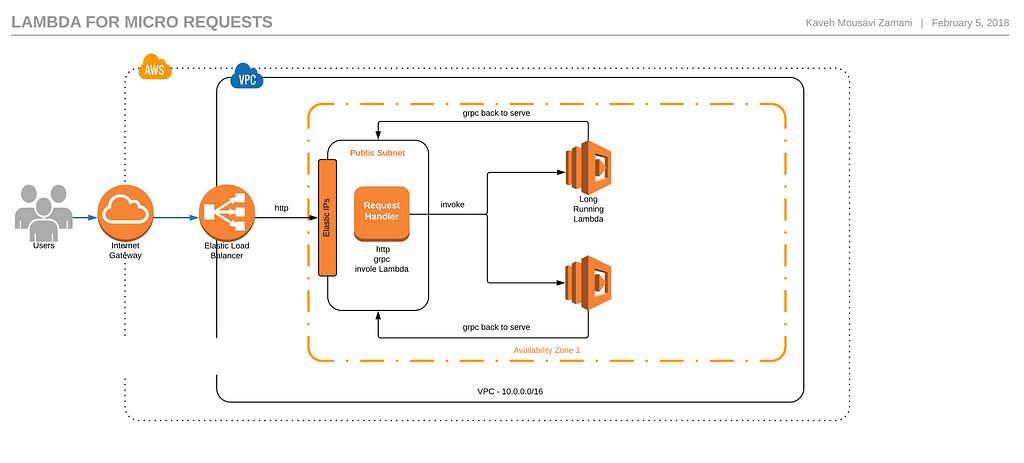Latest news about Bitcoin and all cryptocurrencies. Your daily crypto news habit.
Background
- Past: Dealing with rigid bare-matal servers. minimum granuality : -
- Recently — Setting up an auto-scaling environment, using Kubernetes or other tools. Scaling up and down based on incoming requersts. minimum granuality : one VM
- Today — Using Lambda or Google functions we can scale up to 10,000 cpu in few seconds and then scale down to nothing. minimum granuality: one core, 128GB ram
For both AWS Lambda and Google cloud functions the catch is their mininum 100ms time granuality.
It means if I want to serve my http requests, and they only take 10ms, I will pay 10x more because both platforms will charge me for 100ms of time. Based on current pricing it is expensive.
Solution
Here the idea is to invoke a Lambda function but instead of asking it to do one reuqest we will keep it around to serve many more.
Method is easy.
We create a http server and also a gRPC server. When we have traffic we invoke one or more Lambda fuctions.
Those Lambda functions create a bidirectional connection to our gRPC server which is running along with http server.
Now http server relays the load to Lambda functions through grpc and gets the result back.
We just need a mechanism to invoke enough Lambda function to handle our traffic.
I wrote a framework to help in this case: https://github.com/kavehmz/jobber
Solution does not depend on these, but I picked gRPC as RPC framework and protobuf as data interchange format and Go to implement it.
Data interchange format
Protobuf is a simple format.
Payload definition is at payload/payload.proto.
If you are gonna encode/decode your data what is there is enough, otherwise edit payload.proto and regenereate the go file.
Lambda scheduler
To invoke Lambda function you need to pass the scheduler to NewJobber.
I implemented to scheduler.
- goroutine.Goroutine: a dummy scheduler which is there only for test purposes.
- awslambda.LambdaScheduler: A simple scheduler which can invoke a lambda function to send the jobs to it.
s := grpc.NewServer() taskMachine = jobber.NewJobber(jobber.Scheduler(&goroutine.Goroutine{GrpcHost: "localhost:50051"})) taskMachine.RegisterGRPC(s)Scheduler need to implements the following inteface:
interface { // Inbound is called before a new task is added. Inbound() // Done is called when a task is done Done() // Timedout is called when no response was received on time for a task Timedout()}Test run
example includes a dummy test case and also an example of using lamba scheduler.
just to see how it all works simply do the following
In one terminal run the example
$go run example/goroutine/main.go 2018/02/11 14:48:57 Start listening gRPC at 500512018/02/11 14:49:17 minion: job inbound 0 02018/02/11 14:49:17 worker[1]: Hi, I was invoked and I am trying to connect to accept jobs2018/02/11 14:49:17 worker[1]: I Joined the workforce2018/02/11 14:49:17 server: A new minion joined to help2018/02/11 14:49:17 server: got a job2018/02/11 14:49:17 worker[1]: reveiced a task from server data:"This is the payload I will send to Lambda." 2018/02/11 14:49:18 worker[1]: task is done2018/02/11 14:49:18 server: received the response2018/02/11 14:49:18 server: send the response2018/02/11 14:49:18 server: send the response back to client2018/02/11 14:49:18 minion: job done2018/02/11 14:49:18 Example: Recevied data:"2018-02-11 14:49:18.623911211 +0100 CET m=+21.589500545" <nil>
In another terminal send a request
$ curl 'http://localhost:8000/'2018-02-11 14:49:18.623911211 +0100 CET m=+21.589500545
In the code, your request goes to http server. Your handler will call Do and wait for response. Managing Lambda functions and sending and receiving message is done by jobber
resp, err := myJobber.Do(&payload.Task{Data: "This is the payload I will send to Lambda."})if err != nil { resp = &payload.Result{Data: "Because of error result was returned as nil"}}log.Println("Example: Recevied", resp, err)fmt.Fprint(w, resp.Data)Test Lambda
If you are familiar with Lambda function, setting up one is easy.
But notice lambda functions need to connect back you the grpc server which Jobber depends on. So they must be in the same network (VPC), or somehow they need to have access you your grpc port.
You can see a simple example as example/lambda and a sample Lambda function which does nothing at exmaple/aws_func.
Using AWS Lambda functions for micro jobs was originally published in Hacker Noon on Medium, where people are continuing the conversation by highlighting and responding to this story.
Disclaimer
The views and opinions expressed in this article are solely those of the authors and do not reflect the views of Bitcoin Insider. Every investment and trading move involves risk - this is especially true for cryptocurrencies given their volatility. We strongly advise our readers to conduct their own research when making a decision.

